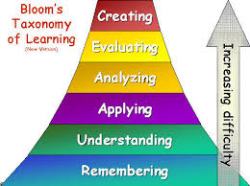This post was originally published on Edudemic you can click here to view the original.
When was the last time your students said “Wow, that worksheet changed my life”? Can you even remember a similar cookie cutter classroom activity or assignment from your days as a student? Yet they were a popular tool because they were structured and efficient in getting the class to a set finish point.
Education, guided by a focus on Bloom’s Revised Taxonomy, is moving towards an emphasis on creation and innovation in the classroom. Though technology did not spark this movement, it has fueled the process by providing students with exciting and powerful tools. But is creation synonymous with learning? Can students even create without learning? How can we ensure that what they create has value?
The Exploding Volcano Project
The past archetype for creation in schools is best embodied by the Exploding Volcano Project. Picture two students standing before the class nervously combining the vinegar, baking soda, and red food coloring that sets the explosion in motion. The class cheers as the small toy figures are consumed by the red wave of destruction.
The real question for teachers the becomes “Did the students presenting, and the other students in class, truly understand the learning objective behind the project?” If they did, then the lesson was a success and that volcano provided a dynamic form of class engagement tied to the learning objective. If they did not, the lesson produced a time consuming distraction that – despite the oohs, aahs and excitement – produced no learning.
4 Strategies To Ensure Students Learn While Creating
Teachers need to help their students move past the flashy excitement of the best creation tools and establish a laser focus on their learning objective. Student work should be an expression of learning not just the mastery of a tool.
1. Start with your specific learning objective.
Define the objective of your lesson clearly and effectively, then communicate it to you class. Allowing your students to have freedom and choice is much easier when those options revolve around a clear mission. Framing that mission for your class is where it all begins, and if done incorrectly, where things can come undone.
2. The idea to be expressed comes before the tool used to express it.
In reality, all products are in essence an essay expressed through a different medium. Whether you call it a “main idea,” a “thesis,” or something else, all student projects should begin with one. This is the student’s unique take on demonstrating the class objective, and should guide their research, organization, as well as their choice of tool.
3. Make asking “How will this show mastery of the learning objective?” your classroom mantra.
Doing this will help students to keep the assignment on task and evaluate the effectiveness of their work and allowing them to reflect on their current knowledge. This constant articulation of the learning objective in their own words develops a crucial metacognitive skill: the ability to evaluate their own progress.
4. Engage in evaluating the PROCESS of creation and not just grading the finished product.
Technology creates well-polished products. At first glance, a well-edited video or a visually pleasing presentation can impress, but upon further evaluation, it may be of little substance. Creating check-ins and opportunities for peer and teacher review can keep the learning objective in view as well as support the development of skills. Watching a student construct meaning, formulate how to express it to an audience, and THEN create a presentation, offers more opportunity to foster growth than just collecting an assignment ever will.
The following creation example illustrates how one student chose to demonstrate his mastery of the learning objective “Describe and communicate the ideas and philosophies that arose in response to the industrial revolution.”
While many students chose posters or graphic organizers to explain these concepts, this student, gifted as a musician, chose to write this song. As you listen, ask yourself if it meets the objective, and if it represents learning.









